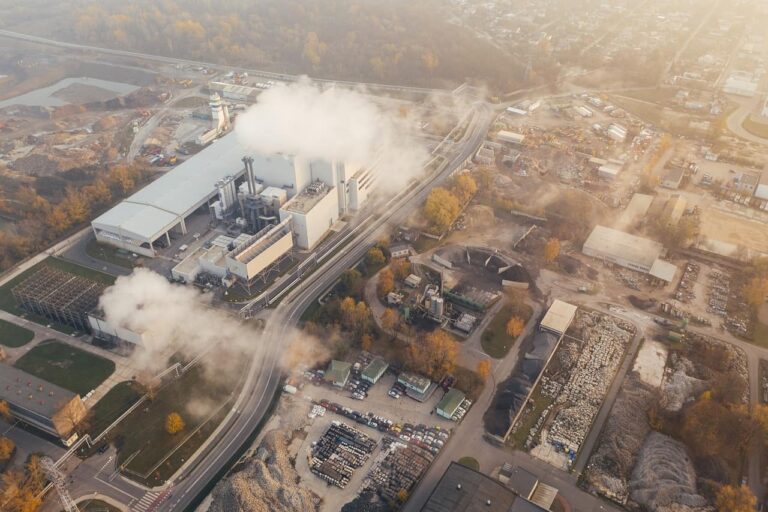Greenhouse gases are gases that are present in the Earth’s atmosphere and have the ability to trap and retain heat from the sun, contributing to the greenhouse effect. These gases absorb and emit radiation within the thermal infrared range, effectively acting as a thermal blanket for the planet.
Solar energy that reaches our atmosphere undergoes a two-fold process: a part of it is reflected back into space, while the remainder is absorbed and then re-emitted by greenhouse gases.
These gases encompass carbon dioxide (CO2), methane (CH4), nitrous oxide (N2O), and fluorinated gases, all of which are produced by both natural phenomena and human-induced activities such as fossil fuel combustion, deforestation, and various industrial operations.
The capacity of each greenhouse gas to absorb heat varies due to its unique chemical composition and lifespan. For example, despite being less prevalent and having a shorter atmospheric lifetime than carbon dioxide, methane is more adept at retaining heat, rendering it a more potent greenhouse gas in terms of its warming effect.
Table of Contents
The greenhouse effect
The greenhouse effect naturally warms the Earth’s surface and is critical for supporting life. It works in conjunction with greenhouse gases to maintain the Earth’s temperature at a level that makes it hospitable for living organisms.
Here’s a simplified explanation of how the greenhouse effect works:
- the sun emits energy in the form of light and heat;
- the Earth absorbs a portion of this solar energy, which warms the planet’s surface;
- in turn, the Earth emits some of this energy back into the atmosphere as heat, known as infrared radiation;
- greenhouse gases in the atmosphere, including methane, carbon dioxide, nitrous oxide, and fluorinated gases, absorb this heat;
- once absorbed, these gases re-emit the heat in all directions, including back toward the Earth’s surface. This redistribution of heat causes the warming effect we know as the greenhouse effect.
Greenhouse gases act like a blanket, insulating the Earth and preventing some heat from escaping into space. It’s important to note that the greenhouse effect is a necessary and natural process.
Without it, the Earth’s average temperature would be about -18 degrees Celsius (or 0 degrees Fahrenheit), which would be too cold to support most life forms as we know them.
What are the main greenhouse gases?
Four main types of greenhouse gases contribute to the greenhouse effect. These are:
- Carbon Dioxide (CO2): C02 is the most significant greenhouse gas and is primarily produced through human activities, e.g., burning fossil fuels such as coal, oil, and natural gas. Deforestation also contributes to higher CO2 levels, as trees absorb CO2 when they grow and release it back into the atmosphere when they are cut down, decayed, or burned;
- Nitrous Oxide (N2O): N20 is released during industrial and agricultural activities, combustion of fossil fuels and biomass, and wastewater treatment;
- Methane (CH4): Methane is a potent greenhouse gas, although its concentration is much lower than CO2. It is released during coal, oil, and natural gas production and transport. Methane is also emitted by the decay of organic waste in municipal solid waste landfills;
- Fluorinated Gases: These are synthetic, high-impact gases that are emitted from a variety of industrial applications. These are much less common but are particularly potent when released into the atmosphere because they can stay there for long periods.
How to reduce greenhouse gases?
Several strategies can be implemented at different levels – international, national, local, and individual – to reduce greenhouse gas emissions:
- International agreements: Countries can work together to establish and meet emissions reduction goals. An example of this is the Paris Agreement, a multi-country treaty designed to limit global warming to below 2oC above pre-industrial levels;
- National policies and initiatives: Governments can implement policies that promote renewable energy, improve energy efficiency, and reduce carbon emissions. This can include laws or regulations to limit emissions from power plants and vehicles;
- Individual actions: On an individual level, there are many ways to reduce greenhouse gas emissions. This includes reducing, reusing, and recycling; using energy-efficient appliances; reducing the consumption of energy-intensive meat products; conserving water, etc;
- Technological innovations: Developing and adopting new technologies can also play a key role in reducing greenhouse gas emissions. This can include carbon capture and storage technologies, advancements in renewable energy technologies, and the development of more efficient transportation and industrial systems;
- Reforestation and afforestation: Trees absorb CO2 from the atmosphere. So planting new forests (afforestation) and promoting the growth of existing forests (reforestation) can help to reduce greenhouse gases.
Greenhouse gases act like a blanket, insulating the Earth
Understanding and addressing greenhouse gases is critical to mitigating climate change. These gases, primarily methane, carbon dioxide, nitrous oxide, and fluorinated gases, play a significant role in the Earth’s temperature regulation.
However, human activities have led to their increased concentration in the atmosphere, intensifying the greenhouse effect and global warming. By familiarizing ourselves with the sources and impacts of these gases and actively participating in implementing measures to significantly reduce greenhouse gas emissions, we can contribute to the global effort to combat climate change. It is our responsibility to protect our planet for ourselves and future generations.
Read also: The 5 reasons to phase out the fossil fuels era and embrace a greener energy future












